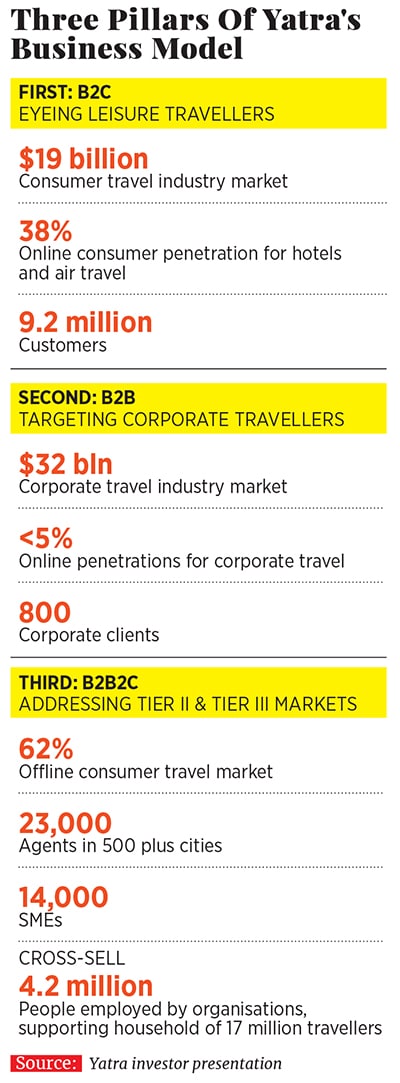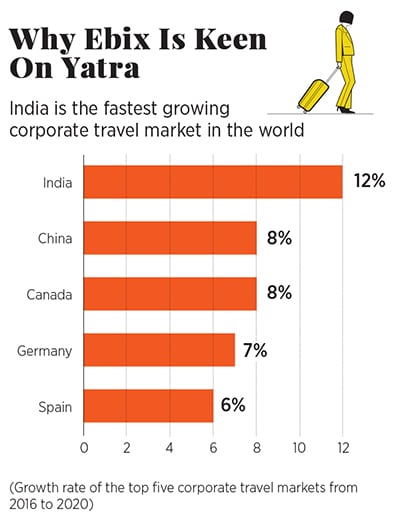
Yatra's eventful trip from buyer to buyout target
In mid-March, software firm Ebix offered to acquire Yatra Online reportedly for $336 million--a premium of over 84 percent of what Yatra was trading in early March
 Yatra co-founders Dhruv Shringi (centre), Manish Amin (right) with COO Sharat Dhall
Yatra co-founders Dhruv Shringi (centre), Manish Amin (right) with COO Sharat DhallImage: Madhu kapparath
In a research report last July, Citi reckoned that Yatra could be a potential buyout target. Reason: The largest Indian online venture in corporate travel and the second largest in the consumer/leisure market would be a perfect launch pad for a global player looking to enter India.
Nine months down the line, the prophecy has turned out to be true. In mid-March, the Nasdaq-listed software firm Ebix offered to acquire Yatra Online reportedly for $336 million, or ₹2,345 crore—a premium of over 84 percent of what Yatra was trading in early March. In a media release a few days after the buyout offer, Yatra informed it had entered into a ‘mutual confidentiality agreement’ with Ebix to further consider the proposal.
For Dhruv Shringi, co-founder of India’s second biggest online travel aggregator (OTA) by revenue, it’s been a long, eventful trip since he along with Manish Amin and Sabina Chopra incorporated Yatra in 2006. The launch was just a year after rival and India’s biggest OTA MakeMyTrip (MMT) started India operations. MMT was founded in 2000, with a focus on the United States.
Yatra had a smooth run to begin with. Actor Boman Irani became its first brand ambassador in 2007 with Salman Khan following suit five years later. However, it was towards the end of 2012 that the Gurugram-headquartered venture started facing strong headwinds.
It all started with the grounding of Kingfisher Airlines due to its bloated debt and mounting losses. The turmoil at the private airline coincided with a two-year period in which oil prices ballooned, air fares surged, and flight bookings dipped. The worst, though, was yet to come. Goibibo, owned by South African media conglomerate Naspers, became hyper aggressive in offering hotel discounts in 2015, triggering a bleeding cash burn game among all major players who were trying to match the financial might of their deep-pocketed rival.

“There was this worry that if we didn’t participate, we would miss out,” recalls Shringi, adding that the two years beginning 2015 were intense in terms of cash burn. Every player, he recounts, was trying to figure out the best course of action. For Yatra, shifting focus on corporates seemed to be the best way out.
Cut to 2019. “The fear of missing out has dissipated on the back of the strength of the brand,” beams Shringi. The Nasdaq-listed Yatra is now the largest corporate travel service provider in India in terms of gross bookings, boasts of over 800 corporate clients, and its business to business (B2B) segment—which is estimated to contribute 60 percent to revenue—is profitable. “Corporate travel in India is a more exciting and larger opportunity for us,” he says. Yatra’s unique strategy, he lets on, of creating a symbiotic relationship between business and leisure travel, has enabled it to capture the highest spend and loyalty of corporates, as well as to serve the low cost-conscious and opportunistic leisure travellers.

What is adding credence to the corporate makeover of Yatra, from a B2C brand catering to discount-hungry consumers to a B2B one meeting tough expectations of business clients, is the progress made towards achieving operating break-even in the near-term. Take, for instance, steps taken during the October-December quarter (Q3). It optimised marketing cost, drove up cross-sell revenues, closed some loss-making accounts in corporate customer portfolio, outsourcing call-centre operations, and shut down physical retail stores. Yatra’s corporate avatar, underlines Shrinji, is an extension of its consumer activity. Over the next few years, the lines between business and leisure travel will blur, with employees being the consuming class of India, predicts Shringi. The target now is to strike a balance between healthy growth and profit.
(This story appears in the 30 November, -0001 issue of Forbes India. To visit our Archives, click here.)








